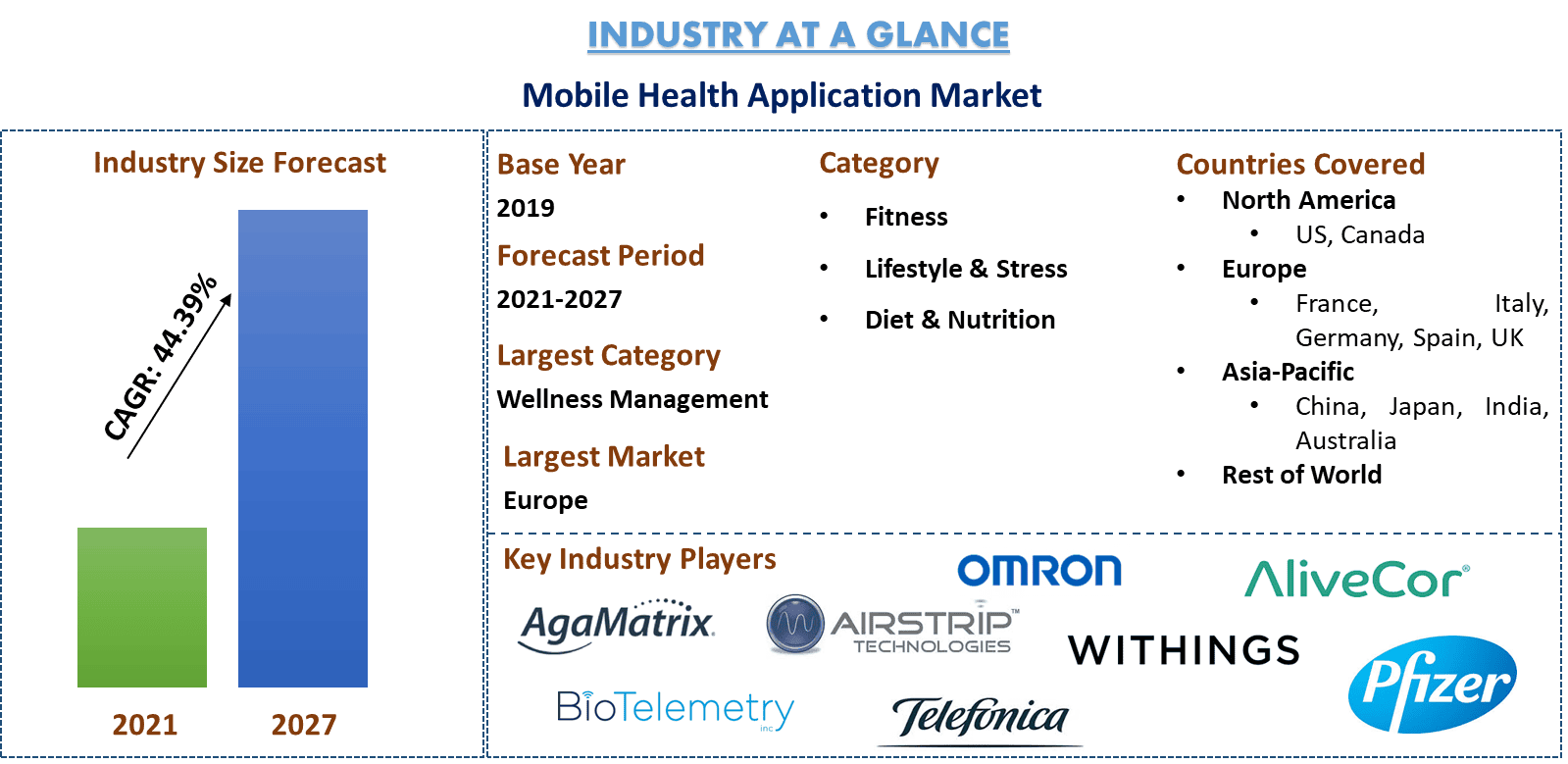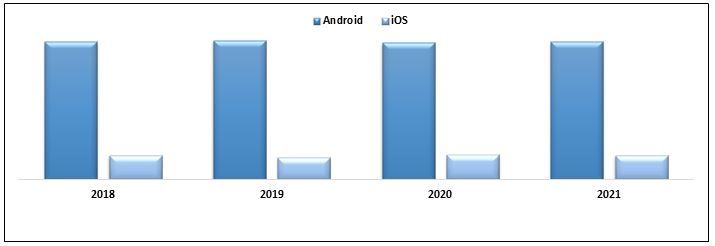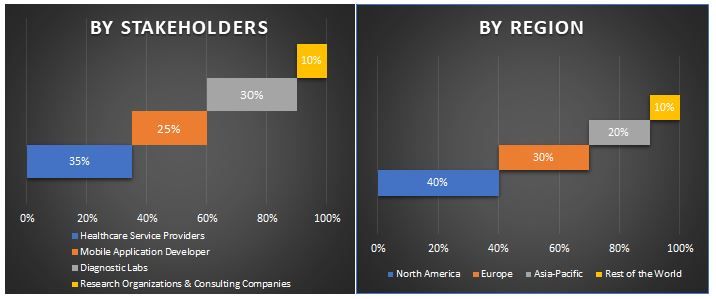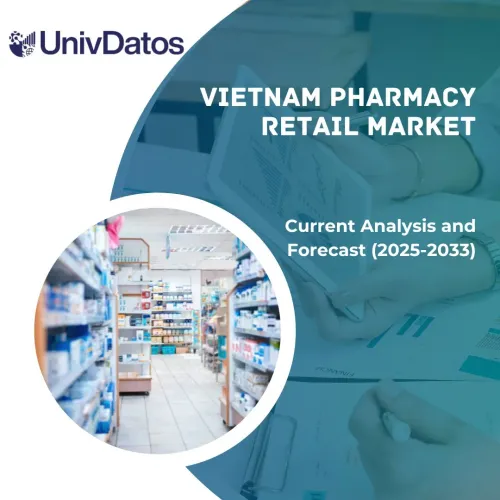- Home
- About Us
- Industry
- Services
- Reading
- Contact Us
Mobile Health (mHealth) Application Market: Current Analysis and Forecast (2020-2027)
Emphasis on Category [Disease and Treatment Management (Healthcare Providers/Insurance, Medication Reminder & Info, Women Health/Pregnancy, Disease specific), Wellness Management (Fitness, Lifestyle & Stress, Diet & Nutrition), Others], Services (Monitoring Services, Fitness Solutions, Diagnostic, Treatment, Others), Operating System (Google Play Store, Apple App Store, Others), Technology (AI-enabled, Non-AI enabled), and Region/Country

Mobile Health Application is one of the most powerful health tools. The advancements and awareness in the health care sector such as the adoption of smart wearables, keep track of daily activities, etc. have added growth to the market of mobile health applications. Moreover, other advancements such as smartphones being used as diagnostic devices, etc. are leading to the growing number of healthcare applications. In a study, it was revealed that over 100,000 health applications are available for download on several platforms such as android, iOS, etc., and this number is expected to proliferate exponentially as technology and healthcare continue to develop side by side. Moreover, the adoption and use of mobile health applications by the healthcare service provider such as clinics, hospitals, diagnostics labs, etc., for several purposes such as collecting accurate clinical history, recording objective patient parameters, supporting the decision-making process, help in communication with patients, educating patients, and monitoring treatment adherence are leading to the growth of the market.
A rise in internet penetration coupled with smartphone adoption is one of the factors which the majorly contributing to the growth of the mobile health application market. As per a report by Datareportal, Internet users are currently growing at an annualized rate of more than 7%, equating to an average of more than 875,000 new users each day and around 60% of the global population have internet access. Also, around 48.53% of the global population have a smartphone as of 2020. Earlier in the year 2016, the percentage of people who have smartphones was 33.58%. The availability of smartphones at an affordable price is adding pace to the market growth. As per IDC, the smartphone shipments in Q4 2020 grew 2.4%. However, it is expected that smartphone shipments would increase by 4.4% in 2021.
Furthermore, a rise in the geriatric population, adoption of a sedentary lifestyle among millenniums globally is resulting in the emergence of several chronic diseases. Also, the busy and hectic lifestyle coupe with the several benefits of mobile health applications such as time and money savings, easy access to doctors, etc. are leading to greater adoption of the applications. Therefore, the market is witnessing an uptick.
Global Smartphone Shipment, By Platform, 2018-2021F
AgaMatrixInc., AirStrip Technologies, Omron Corporation, Withings, Biotelemetry, Inc., Telefonica, AliveCor, Inc., Pfizer, Inc, Merck and Co., Inc, and Sanofi are some of the prominent players operating in the global Mobile Health Application market. Several M&A’s along with partnerships have been undertaken by these players to facilitate customers with hi-tech and innovative products.
Insights Presented in the Report
“Amongst category, Wellness management segment holds the major share”
Based on the category, the market is fragmented into disease and treatment management, wellness management, and others. Wellness management dominated the market with a share of 62.6% in 2019 and is expected to maintain its dominance during the forecast period owing to the end-users’ awareness about the benefits of wellbeing and the rising prevalence of several communicable and non-communicable diseases.
“Amongst wellness management, fitness segment is anticipated to dominate the market during the analyzed period”
Furthermore, the wellness management market is mainly bifurcated into fitness, lifestyle and stress, and diet & nutrition. In 2019, the fitness sub-segment accounted for a maximum market revenue share of 55.2% and is expected to remain dominant during the analyzed period owing to the increasing millennium’s inclinations towards health and fitness. However, the diet & nutrition segment is anticipated to grow at a substantial CAGR over the forecast period.
“Amongst disease and treatment management type, the disease-specific segment dominated the market during the forecast period”
Based on disease and treatment management type, the market is mainly fragmented into healthcare providers/insurance, medication reminder, women health/pregnancy, and disease-specific. In 2019, the disease-specific segment accounted for a maximum market revenue share of 50% and is expected to remain dominant during the analyzed period. However, Medication Reminder & Info segment is forecasted to witness the highest CAGR during the forthcoming years.
“Amongst services, monitoring services segment holds the major share”
Based on services, the market is bifurcated into monitoring services, fitness solutions, diagnostic services, treatment services, and others (health practitioner support, administration, prevention). In 2019, the monitoring services segment accounted for the maximum market share with 65% and is expected to be the leading segment of the mobile health application market during the forecast period due to the launch of health monitoring applications by the prominent players and adoption among end-users owing to its benefits.
“Amongst the operating system type, google play store segment dominated the market during the forecast period”
Based on the operating system type, the market is mainly disintegrated into the google play store, apple app store, and others. In 2019, the google play store segment accounted for a maximum market revenue share of 61.2% and is expected to remain dominant during the analyzed period owing to the availability of android phones at a reasonable price.
“North America represents one of the largest markets of mHealth Apps market”
For a better understanding of the market dynamics of the mobile health application market, a detailed analysis was conducted for different regions across the globe including North America (the U.S, Canada, and the Rest of North America), Europe (Germany, France, Italy, Spain, United Kingdom and Rest of Europe), Asia-Pacific (China, Japan, Australia, India, and Rest of APAC), and Rest of the World. North America dominated the market and generated revenue of US$ 4.7 billion in 2019 owing to the high prevalence rate of chronic disease, adoption of smartphones, and the increasing seed surging to the m-health application startups in the region.
Reasons to buy this report:
- The study includes market sizing and forecasting analysis validated by authenticated key industry experts
- The report presents a quick review of overall industry performance at one glance
- The report covers an in-depth analysis of prominent industry peers with a primary focus on key business financials, product portfolio, expansion strategies, and recent developments
- Detailed examination of drivers, restraints, key trends, and opportunities prevailing in the industry
- The study comprehensively covers the market across different segments
- Deep dive regional level analysis of the industry
Customization Options:
The mobile health application market can further be customized as per the requirement or any other market segment. Besides this, UMI understands that you may have your own business needs, hence feel free to connect with us to get a report that completely suits your requirements.
Table of Content
Analyzing the historical market, estimation of the current market, and forecasting the future market of the Global Mobile Health Application Market were the three major steps undertaken to create and analyze the adoption of Mobile Health Application for the different diseases across major regions globally. Exhaustive secondary research was conducted to collect the historical market numbers and estimate the current market size. Secondly, to validate these insights, numerous findings and assumptions were taken into consideration. Moreover, exhaustive primary interviews were also conducted, with industry experts across the value chain of the Mobile Health Application sector. Post assumption and validation of market numbers through primary interviews, we employed a top-down approach to forecasting the complete market size. Thereafter, market breakdown and data triangulation methods were adopted to estimate and analyze the market size of segments and sub-segments the industry pertains to. Detailed methodology is explained below:
Analysis of Historical Market Size
Step 1: In-Depth Study of Secondary Sources:
The detailed secondary study was conducted to obtain the historical market size of the mobile health application through company internal sources such as annual report & financial statements, performance presentations, press releases, etc., and external sources including journals, news & articles, government publications, competitor publications, sector reports, third-party database, and other credible publications.
Step 2: Market Segmentation:
After obtaining the historical market size of the mobile health application market, we conducted a detailed secondary analysis to gather historical market insights and share for different segments & sub-segments for major regions. Major segments included in the report are category, services, operating system type, and technology. Further country-level analyses were conducted to evaluate the overall adoption of a mobile health application in that region.
Step 3: Factor Analysis:
After acquiring the historical market size of different segments and sub-segments, we conducted a detailed factor analysis to estimate the current market size of mobile health applications. Further, we conducted factor analysis using dependent and independent variables such as rising internet penetration and smartphone adoption. A thorough analysis was conducted for demand and supply-side scenario considering top partnerships, merger and acquisition, business expansion, and product launches in the mobile health application industry across the globe.
Current Market Size Estimate & Forecast
Current Market Sizing: Based on actionable insights from the above 3 steps, we arrived at the current market size, key players in the mobile health application market, and market shares of the segments. All the required percentage shares split, and market breakdowns were determined using the above-mentioned secondary approach and were verified through primary interviews.
Estimation & Forecasting: For market estimation and forecast, weights were assigned to different factors including drivers & trends, restraints, and opportunities available for the stakeholders. After analyzing these factors, relevant forecasting techniques i.e. top-down approach was applied to arrive at the market forecast about 2027 for different segments and subsegments across the major markets globally. The research methodology adopted to estimate the market size encompasses:
- The industry’s market size, in terms of value (US$) and the adoption rate of mobile health application across the major markets domestically
- All percentage shares, splits, and breakdowns of market segments and sub-segments
- Key players in the Mobile Health Application market in terms of services offered. Also, the growth strategies adopted by these players to compete in the fast-growing market
Market Size and Share Validation
Primary Research: In-depth interviews were conducted with the Key Opinion Leaders (KOLs) including Top Level Executives (CXO/VPs, Sales Head, Marketing Head, Operational Head, and Regional Head, Country Head, etc.) across major regions. Primary research findings were then summarized, and statistical analysis was performed to prove the stated hypothesis. Inputs from primary research were consolidated with secondary findings, hence turning information into actionable insights.
Split of Primary Participants in Different Regions
Market Engineering
Data triangulation technique was employed to complete the overall market estimation and to arrive at precise statistical numbers of each segment and sub-segment of the mobile health application market. Data was split into several segments & sub-segments post studying various parameters and trends in the areas of monitoring services, fitness solutions, disease-specific mobile health application market.
Main Objective of the Mobile Health Application Market Study
The current & future market trends of mobile health applications were pinpointed in the study. Investors can gain strategic insights to base their discretion for investments from the qualitative and quantitative analysis performed in the study. Current and future market trends were determined the overall attractiveness of the market at a regional level, providing a platform for the industrial participant to exploit the untapped market to benefit as a first-mover advantage. Other quantitative goals of the studies include:
- Analyze the current and forecast market size of a mobile health application in terms of value (US$). Also, analyze the current and forecast market size of different segments and sub-segments
- Segments in the study include areas of category, services, operating system type, and technology
- Analyze the value chain involved with the presence of various intermediaries, along with analyzing customer and competitor behaviors of the industry
- Analyze the current and forecast market size of the mobile health application market for the major region
- Major regions studied in the report include North America (the U.S and Canada), Europe (Germany, France, Italy, Spain, and United Kingdom), Asia-Pacific (China, Japan, India, and Australia), Rest of the World
- Company profiles of the mobile health application market and the growth strategies adopted by the market players to sustain in the fast-growing market
- Deep dive regional level analysis of the industry
Related Reports
Customers who bought this item also bought












